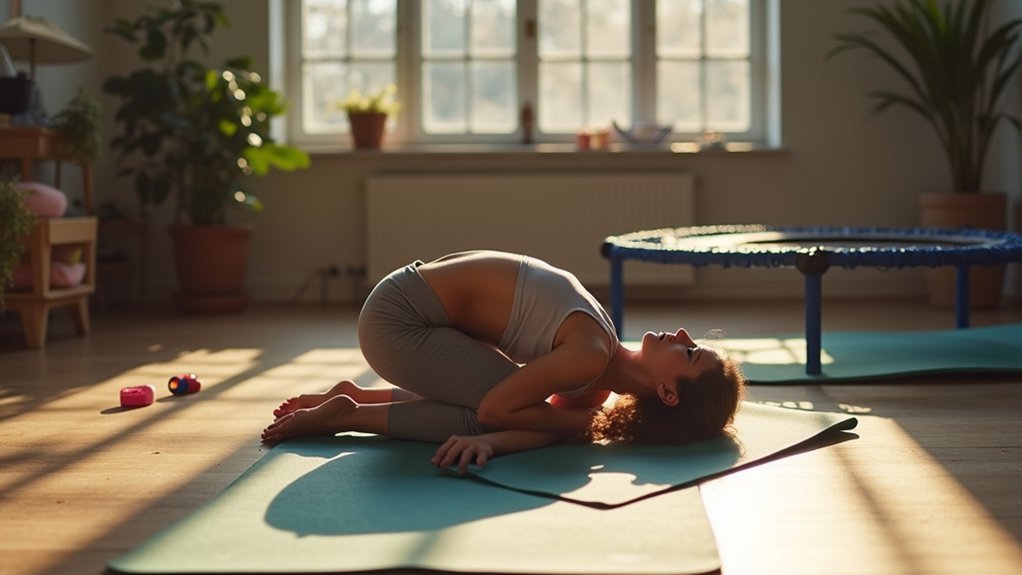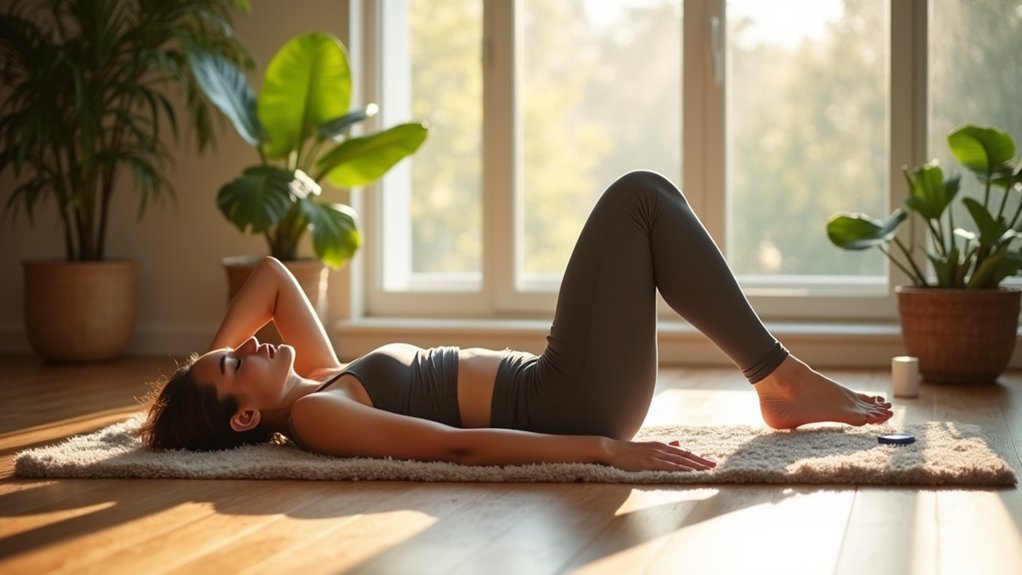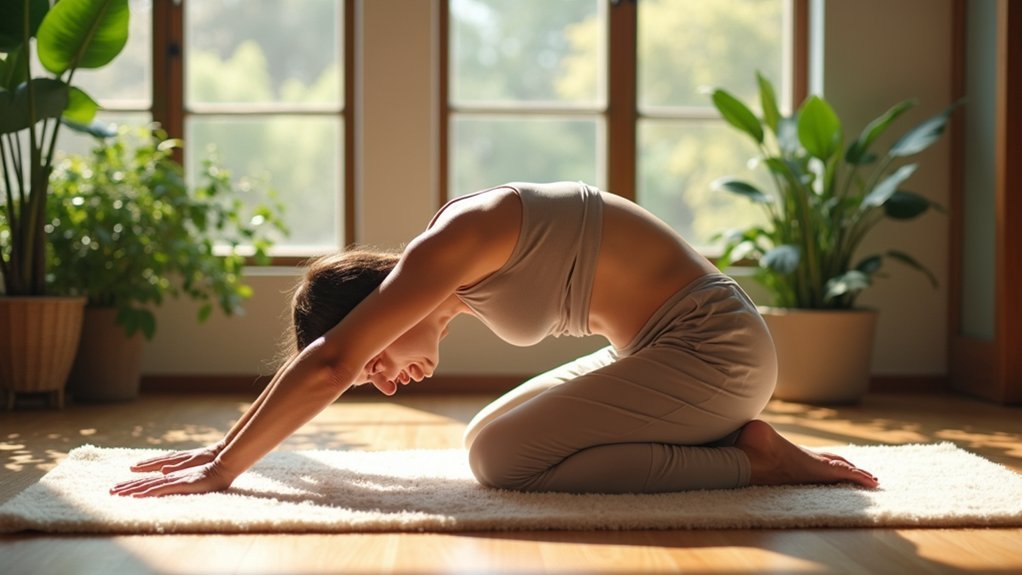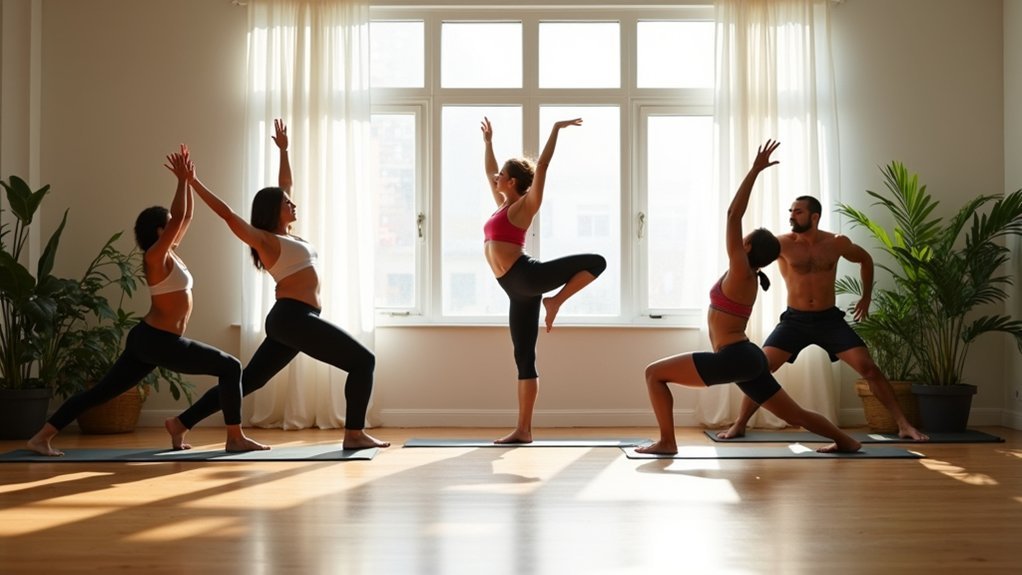After rebounding workouts, try these five restorative yoga poses: Child’s Pose to relieve muscle fatigue, Downward-Facing Dog to decompress your spine, Supine Twist to release lower back tension, Cobra Pose to counter forward flexion, and Forward Fold to initiate deep relaxation. These poses enhance recovery by stretching worked muscles, realigning your posture, and triggering your parasympathetic nervous system. Discover how just 3-5 minutes in each position can dramatically improve your post-workout resilience.
Rebounding Relief: Child’s Pose for Trampoline Training Recovery

When your body has absorbed the impact of countless jumps during trampoline training, Child’s Pose offers the perfect counterbalance to restore and rejuvenate tired muscles. This gentle position realigns your posture while releasing tension in your core and back—areas that work overtime during rebounding sessions. Unlike recreational jumping, this recovery technique complements the therapeutic benefits of Rebound Therapy established for rehabilitation purposes.
As you settle into Child’s Pose, focus on deep breathing to enhance recovery and promote stress reduction. This simple practice helps integrate the sensory stimulation you’ve experienced while bouncing, creating a calming effect on your nervous system.
Child’s Pose is accessible for all fitness levels, making it an ideal complement to your trampoline routine. It’s particularly effective for preventing injuries by gently stretching muscles that tighten during rebounding, ensuring you’ll bounce back stronger for your next session.
Downward-Facing Dog: Stretching After Bouncing Workouts
After the repetitive impact of trampoline exercises, Downward-Facing Dog provides the perfect full-body reset your muscles crave. This pose simultaneously decompresses your spine while strengthening your upper body and stretching your posterior chain—counteracting that forward-hunched position you might adopt during bouncing sessions. This gentle inversion reverses downward pressure on your spine, allowing for natural realignment after high-impact activities.
- Shoulder Relief: External rotation of your shoulders while bearing weight strengthens your rotator cuffs and scapular muscles, preventing impingement injuries common in trampoline enthusiasts.
- Lower Body Recovery: The gentle stretch through your hamstrings and calves helps release tension built up from repetitive jumping, while promoting circulation to flush out metabolic waste.
- Core Stabilization: Engage your transverse abdominis by drawing your navel toward your spine, creating the internal pressure needed to support your back during future workouts.
Remember to micro-bend your knees if hamstrings feel tight!
The Supine Twist: Releasing Tension After Rebounding Sessions

The repetitive bouncing motion of trampoline workouts creates a unique strain pattern in your spine and hips that the Supine Twist directly addresses.
This pose efficiently releases compression in your lower back while improving spinal mobility after high-impact sessions.
To perform it effectively, lie flat on your back, arms extended in a T-shape. Bend your knees, then gently lower them to one side while keeping your shoulders grounded. For additional support and comfort, you can place a block under the knee that’s being lowered.
Let gravity do the work—don’t force the stretch. Breathe deeply as you hold for 30-60 seconds per side.
You’ll notice both physical and mental benefits—the twist massages your internal organs, enhances digestion, and calms your nervous system.
It’s the perfect counterbalance to the energizing effects of rebounding, preparing your body for complete recovery.
Cobra Pose: Countering Forward Flexion From Trampoline Exercises
Trampoline workouts naturally pull your spine into forward flexion as you jump and land, creating a gradual muscular imbalance that Cobra Pose directly addresses. This powerful backbend decompresses your vertebrae, strengthens your posterior chain, and opens your chest for improved oxygen intake—essential after the cardiovascular demands of rebounding. Trampoline Yoga offers a unique platform for practicing this restorative pose while enhancing flexibility and relaxation through gentle bounce support.
To maximize benefits while protecting your spine:
- Position palms flat under shoulders with elbows hugged inward, activating your core before lifting
- Draw ribs inward while extending through your spine to prevent lumbar compression
- Synchronize breath with movement—inhale as you rise, exhale as you lower vertebra by vertebra
For intensity control, try using yoga blocks under your hands or practice 10-second isometric holds rather than static extension.
Restorative Forward Fold: Decompressing the Spine After Rebounding

Perfectly complementing the backbend work of Cobra Pose, restorative forward folds provide essential decompression for your spine after high-impact trampoline sessions. This pose triggers your parasympathetic nervous system, initiating relaxation responses while simultaneously creating space between vertebrae that rebounding compresses. This gentle position reduces fatigue after intense physical activity, allowing your body to recover more efficiently.
| Benefit | Execution Tip | Modification |
|---|---|---|
| Spinal traction | Hinge from hips, not waist | Use bolster under torso |
| Hamstring release | Maintain slight knee bend | Elevate hips on blanket |
| Parasympathetic activation | Breathe 4-7 counts | Support head on blocks |
| Abdominal organ stimulation | Keep belly soft | Widen legs for stability |
| Fascial release | Hold 3+ minutes | Substitute Downward Dog if injured |
For sciatica or disc concerns, always elevate your sitting base. You’ll counterbalance rebounding’s vertical impact while stimulating lymphatic drainage—essential for removing metabolic waste from your intense workout.
Frequently Asked Questions
How Long Should I Hold Each Post-Rebounding Yoga Pose?
Hold post-rebounding yoga poses for 1-5 minutes depending on your focus. Recovery poses benefit from longer holds, while the rebounding technique itself requires about a 1-minute rest between poses for ideal relaxation.
Can Seniors Safely Perform These Yoga Poses After Trampoline Workouts?
Yes, you can safely do post-trampoline yoga poses as a senior if you follow precautions. Consult your doctor first, use modifications for your ability level, and incorporate supportive equipment when needed for balance.
Are These Poses Suitable Immediately After Rebounding or Wait First?
You can safely do these poses immediately after rebounding when your muscles are warm and flexible. Don’t wait – this timing enhances flexibility, aids recovery, and helps shift your body from exercise to relaxation more effectively.
Should I Modify Poses if I Have Lower Back Issues?
Yes, you should definitely modify poses if you have lower back issues. Use props, choose gentle options like Child’s Pose, and listen to your body. Always consult a healthcare provider before starting yoga with back problems.
Do These Poses Help With Rebounding-Specific Soreness in Calves and Ankles?
Yes, these poses directly address rebounding-specific soreness. They’ll enhance your ankle mobility while releasing calf tension through controlled stretching. The proprioceptive training in balance poses specifically helps stabilize your ankles for future jumping movements.
In Summary
You’ve now got five powerful yoga poses to complement your trampoline workouts. By incorporating these restorative postures, you’ll reduce muscle tension, improve flexibility, and speed up recovery time. Don’t skip this essential cool-down routine—it’s your ticket to maintaining joint health and preventing injuries. Make these poses part of your regular rebounding practice, and you’ll bounce back stronger and more resilient each time.





Leave a Reply